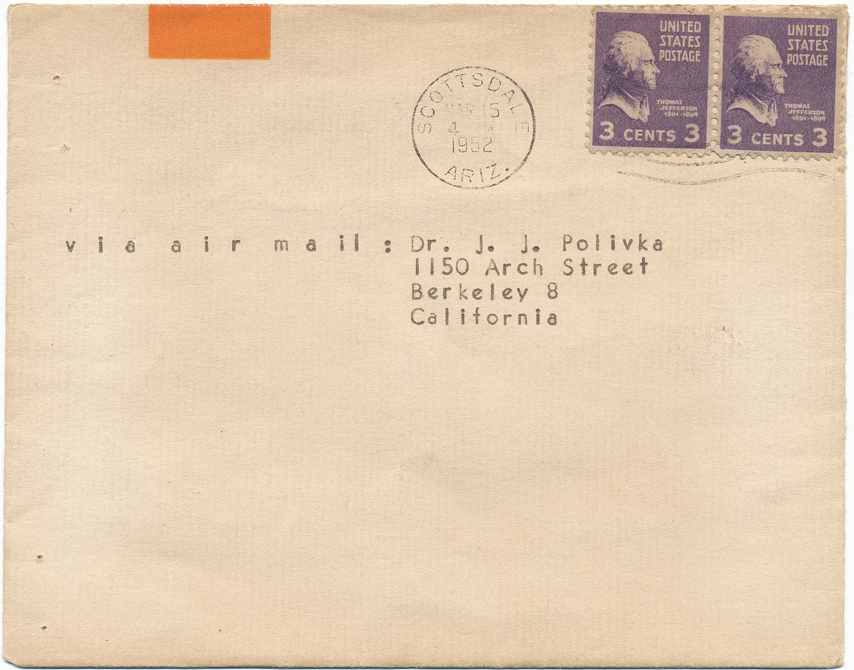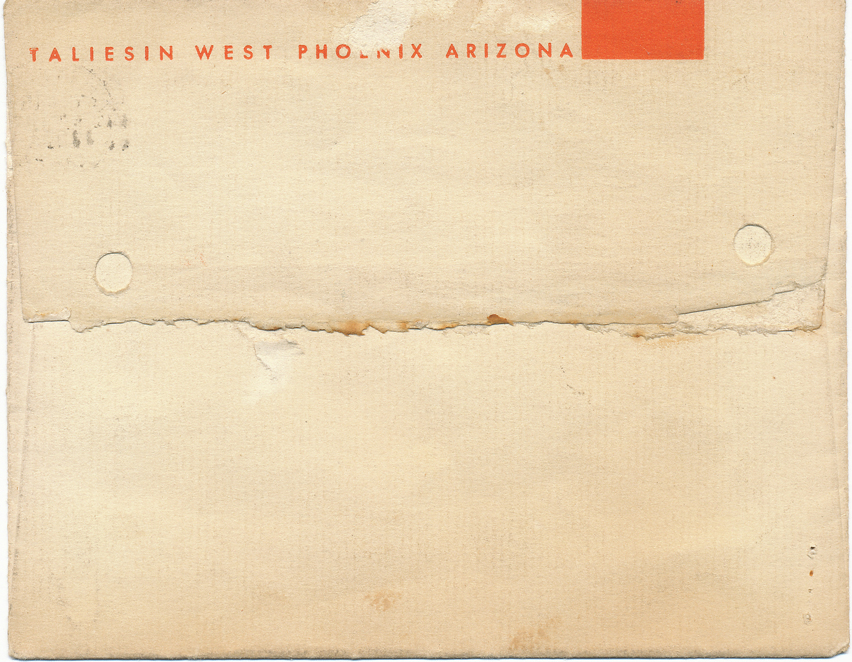Frank Lloyd Wright
Frank Lloyd Wright
Typed Letter Signed to J.J. Polivka - 1952
Historic, previously unpublished Typed Letter Signed to prominent Czech civil engineer Dr. J.J. Polivka, dated March 15, 1952, on embossed Taliesin stationery. Accompanied by original stamped Taliesin West envelope postmarked the same date from Scottsdale, Arizona addressed to Polivka in Berkeley, California.
Clearly upset, Wright sends a remarkably contentious communiqué to a highly regarded professional colleague. In full:
DR. J. J. POLIVKA : 1150 ARCH STREET BERKELEY 8
My dear J. J. Polivka: Due to Aaron Green‘s report of your statement to him that “I owed you money”, some clearing up of our relationship seems imperative and necessary. To my knowledge, if any money is due it is the other way around.
Also, the Abey Fellowship model is a fellowship affair paid for by us. I entrusted it to him to deliver to my office in San Francisco. How it got into your hands is a mystery to me for I never authorized any such proceeding. The model belongs to the Frank Lloyd Wright Foundation as a matter of course. What work you have done upon it without my sanction is questionable. I have not approved it.
Questionable also is your retention of the Morris plans which I loaned you as you wanted the privilege of making an estimate on that job with a view to taking a contract to build it. Perhaps I am wrong in attributing undue assumptions to you as I have not seen you for a long time. If so, I will thank you to write and say so.
Sincerely yours,
/s/ Frank Lloyd Wright
March 15, 1952
(over)
N. B.
It was my understanding in the case of the Bridge that the design being wholly mine (existing before the S. F. came up) that you would receive an engineer’s fee for preparing all detailed reinforcing drawings and a superintendent’s fee under construction. Also you, being on the ground, were to do all in your power to promote the commission to build the bridge.
F. Ll. W.
FRANK LLOYD WRIGHT (1867-1959) was an American architect, interior designer, writer and educator, who designed more than 1,000 projects, which resulted in more than 500 completed works.
Wright promoted organic architecture (exemplified by Fallingwater), was a leader of the Prairie School movement of architecture (exemplified by the Robie House and the Westcott House), and developed the concept of the Usonian home (exemplified by the Rosenbaum House). His work includes original and innovative examples of many different building types, including offices, churches, schools, sky scrapers, hotels, and museums. Wright also often designed many of the interior elements of his buildings, such as the furniture and stained glass.
Wright authored 20 books and many articles, and was a popular lecturer in the United States and in Europe. His colorful personal life often made headlines, most notably for the 1914 fire and murders at his Taliesin studio.
Already well known during his lifetime, Wright was recognized in 1991 by the American Institute of Architects as “the greatest American architect of all time”.
JAROSLAV JOSEPH POLIVKA (aka J. J. Polivka; 1886-1960) was a Civil Engineer born in Prague. He received his undergraduate degree in structural engineering at the College of Technology in Prague in 1909. He then studied at the Federal Polytechnic Institute in Zurich, Switzerland and at the Prague Institute of Technology, where he earned a doctoral degree in 1917. After serving in First World War, he opened his own architectural and engineering office in Prague and developed his skills in stress analysis of reinforced concrete, pre-stressed reinforced concrete and steel structures. Polivka became an expert in photo-elastic stress analysis, a technique that examines small-scale transparent models in polarized light.
In 1946 Polivka began to work with Frank Lloyd Wright collaborating together on several major projects until Wright’s death in 1959. For Wright’s projects Polivka performed stress analyses and investigations of specific building materials. They worked on a total of seven projects, two of which were built: the Johnson Wax Research Tower, 1946-1951 at Racine Wisconsin and the Guggenheim Museum, 1946-1959 in New York. Their other well-known design proposal was the reinforced concrete Butterfly Bridge (proposed at a world record span of 1000-ft) at the Southern Crossing of the San Francisco Bay (1949-52).
It was not until 1946 that Polivka began to work with Frank Lloyd Wright, but once they established a business partnership, the two men worked together until Wright’s death in 1959. Architect Ivan Margolius gives an account of the first interaction between Wright and Polivka in his book, Architects + Engineers = Structures. (Chichester, West Sussex : Wiley-Academy, 2002):
“In 1946 Wright wrote an article in Architectural Forum about the difficulties he had with the steel company engineers who condemned his Fallingwater house (1934-1937) structural design. Wright wrote to Edgar Kaufmann, his client, saying: ‘I should like this box [with this letter] put under the corner stone of your house when the cornerstone is laid. I want this done so that when the house is torn down, 2,000 years from now, people will learn what complete damn fools these engineers are!’ Prague-born structural engineer Jaroslav Josef Polivka (1886-1960) responded to the article by sending Wright an enthusiastic letter: ‘I am admiring you as an engineer, although, according to a quotation in the last Forum issue, these engineers are complete damn fools. You may be right since the engineers in their structural conceptions are very seldom guided by eternal laws of the Nature … The average engineer knows only beams, girders, columns and any deviation from his every day tools is considered as unusual, crazy, or dangerous.’ The letter brought in return Wright’s invitation to Taliesin and opened a professional relationship that lasted until Wright’s death.”
Additional biographical material and life chronology on Mr. Polivka can be found in the excellent archives of the State University of New York at Buffalo.
All Vintage Memorabilia autographs are unconditionally guaranteed to be genuine. This guarantee applies to refund of the purchase price, and is without time limit to the original purchaser. A written and signed Guarantee to that effect accompanies each item we sell.



